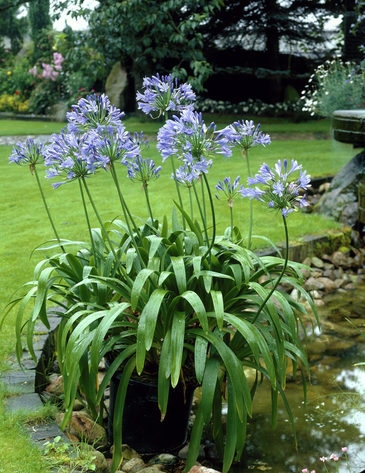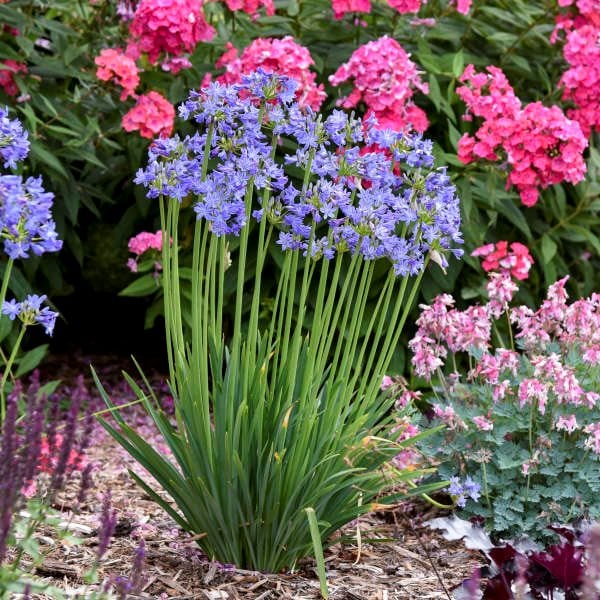Exactly how to Plant and Maintain Agapanthus in Your Garden
Exactly how to Plant and Maintain Agapanthus in Your Garden
Blog Article
Unleashing the Secret to Effective Agapanthus Cultivation: Idea for a Flourishing Yard
In the world of gardening, growing agapanthus efficiently calls for a calculated method that includes numerous elements of plant treatment. With cautious focus to detail, one can open the keys to supporting these sensational blooms, causing a garden that thrives with elegance and vibrancy. By recognizing the subtleties of agapanthus farming, one can create an atmosphere where these plants thrive and flower abundantly. In the adhering to discussion, we will certainly check out vital suggestions and tricks that will assist you towards a flourishing agapanthus yard, offering understandings into ideal practices, dirt conditions, watering strategies, and more.
Growing Agapanthus: Best Practices
When growing Agapanthus, correct dirt prep work is crucial for guaranteeing effective growth and advancement of these stunning blossoms. Agapanthus, commonly understood as Lily of the Nile or African lily, grows in well-draining soil with a somewhat acidic to neutral pH level - Agapanthus. Before growing, it is crucial to change heavy clay soils with organic matter such as compost or peat moss to enhance drain and provide necessary nutrients for the plants
To plant Agapanthus, select an area that receives complete sunlight to partial shade, as this will certainly advertise healthy and balanced growth and plentiful blooming. Dig a hole twice the size of the plant's origin round and place the Agapanthus at the exact same deepness it was previously growing. Carefully backfill the opening with dirt, pushing down securely to eliminate any air pockets around the origins.
Water the newly planted Agapanthus completely and proceed to keep the dirt uniformly damp, specifically during the plant's active growing season. Agapanthus. Using a well balanced plant food once a month can further sustain the plant's development and blooming. By following these best practices for growing Agapanthus, you can create a magnificent display screen of these exciting flowers in your yard
Ideal Soil Conditions for Agapanthus
For ideal growth and blooming success of Agapanthus plants, guaranteeing the dirt problems are excellent is important. Agapanthus prospers in well-draining soil with a slightly acidic to neutral pH level varying from 6.0 to 7.0. This type of dirt permits ample water drain, protecting against waterlogging which can bring about root rot. To boost dirt drainage, consider including raw material such as compost or peat moss when preparing the planting site. In addition, Agapanthus likes soil that is rich in nutrients, so including a balanced plant food during the expanding season can promote healthy growth and lively flowers.

Watering and Fertilizing Tips
To make sure healthy growth and lively blossoms, correct her latest blog watering and feeding strategies are necessary for successful Agapanthus cultivation. Agapanthus plants take advantage of regular watering, especially during the growing period. It is advised to water deeply as soon as a week, making certain the dirt is moist but not waterlogged. Throughout warm weather or in pots, even more frequent watering might be needed to stop the dirt from drying out completely.
When it pertains to feeding Agapanthus, a well balanced fertilizer with equal components nitrogen, phosphorus, and potassium can be find more information applied in the spring to advertise healthy development and flowering. Slow-release fertilizers are perfect for providing nutrients progressively over a prolonged duration. Avoid over-fertilizing, as this can cause extreme foliage development at the expense of flowers.
In addition, incorporating natural matter like garden compost into the dirt can enhance nutrient degrees and enhance soil framework, assisting in the general health and wellness of the Agapanthus plants. By complying with these watering and fertilizing suggestions, garden enthusiasts can ensure their Agapanthus plants prosper and generate spectacular displays of flowers.
Trimming and Deadheading Techniques
Appropriate trimming and deadheading methods play an essential duty in maintaining the wellness and visual appeals of Agapanthus plants, complementing the vital techniques of watering and fertilizing for successful growing. Pruning Agapanthus involves eliminating invested flower heads, yellowing or dead leaves, and overall shaping of the plant to promote much better development. Deadheading, the process of eliminating discolored blossoms, not only improves the plant's appearance but likewise motivates more blooming.
When deadheading Agapanthus, it is a good idea to trim off the flower stem at the base using sharp, tidy shears. This process redirects the plant's power from seed production back right into origin and vegetation development, promoting a healthier and a lot more durable plant. Normal deadheading can expand the growing duration of Agapanthus and avoid self-seeding, which can bring about congestion.
In terms of pruning, Agapanthus typically gain from a light trim after blooming to clean the plant and urge fresh development. Cutting back the invested flower stems and eliminating any type of dead or damaged vegetation assists maintain the plant's vitality and total look. Nevertheless, it is important to stay clear of reducing into the crown of the plant, as this can damage its wellness.

Protecting Agapanthus From Pests and Diseases
Implementing efficient pest and disease administration strategies is vital to safeguarding the health and wellness and vigor of Agapanthus plants in growing. One typical bug that affects Agapanthus is the Agapanthus borer, a caterpillar that tunnels right into the plant, causing damage to the leaves and flowers.
In addition to insects, Agapanthus are prone to conditions such as origin rot and fungal leaf places. These issues can typically be stopped by making certain correct drain and avoiding overwatering. If signs of disease show up, influenced components of the plant need to be without delay eliminated to avoid more spread. Fungicides may also be used as a treatment procedure, adhering to the manufacturer's directions meticulously. By remaining cautious and dealing with insect and illness problems quickly, gardeners can assist their Agapanthus thrive and thrive.

Verdict
In final thought, effective growing of agapanthus calls for proper planting methods, perfect dirt problems, adequate watering and fertilizing, normal pruning and deadheading, and security from pests and diseases. By adhering to these suggestions and techniques, garden enthusiasts why not try this out can make certain a growing yard filled with gorgeous agapanthus blooms. Agapanthus. Remember to preserve regular care and focus to detail to promote the wellness and long life of these sensational plants
When growing Agapanthus, correct soil prep work is necessary for making sure successful development and growth of these attractive flowers.Water the recently grown Agapanthus thoroughly and proceed to maintain the dirt equally wet, especially throughout the plant's energetic expanding period.For ideal growth and growing success of Agapanthus plants, making certain the dirt conditions are perfect is essential. When planting or transplanting Agapanthus, ensure the soil is well-prepared to offer the necessary foundation for the plants to develop themselves effectively. One usual parasite that impacts Agapanthus is the Agapanthus borer, a caterpillar that tunnels into the plant, creating damages to the fallen leaves and flowers.
Report this page